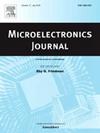An efficient PEH Pseudo-MPPT rectifier using a combination of an enhanced Sense and Set and improved FNOV schemes
IF 1.9
3区 工程技术
Q3 ENGINEERING, ELECTRICAL & ELECTRONIC
引用次数: 0
Abstract
— Even though a Maximum Power Point Tracking (MPPT)-based Piezoelectric Energy Harvester (PEH) Interface Circuit (PEHIC) may improve energy extraction, complex trade-offs between Converter Efficiency, MPPT Efficiency, and Duty-Cycling Efficiency mean that complicated MPPT schemes do not always increase the End-To-End Efficiency. This study investigates these complexities and introduces a balanced solution for Vibration Energy Scavenging.
1The proposed circuit periodically Senses and Sets an adjustable approximation of the Maximum Power Point Voltage, Vmpp, called Vpseudo-mpp, instead of the fixed Voc,max/2 used in standard Maximum Power Point Sensing (MPPSn). A Pseudo-MPPT scheme utilizing a Fractional Normal Operation Voltage (FNOV) method operates as a non-interrupted MPPSn via a novel pre-sampling scheme, relaxed Maximum Power Point Setting (MPPSt) procedure, and highly efficient circuitry to increase Converter Efficiency. The End-To-End Efficiency (ηEnd-To-End) reaches ∼0.52, and for the same input, the proposed circuit extracts 4.6 × more power than a Standard Energy Harvesting (SEH) circuit.
一种高效的PEH伪mppt整流器,结合了增强的Sense和Set和改进的FNOV方案
-尽管基于最大功率点跟踪(MPPT)的压电能量采集器(PEH)接口电路(PEHIC)可以提高能量提取,但转换器效率,MPPT效率和占空比效率之间的复杂权衡意味着复杂的MPPT方案并不总是提高端到端效率。本研究调查了这些复杂性,并介绍了一种平衡的振动能量清除解决方案。1所提出的电路周期性地检测和设置最大功率点电压Vmpp的可调近似,称为vpseodo -mpp,而不是标准最大功率点感应(MPPSn)中使用的固定Voc,max/2。利用分数阶正常工作电压(FNOV)方法的伪mppt方案通过新颖的预采样方案、宽松的最大功率点设置(MPPSt)程序和高效的电路来提高转换器效率,作为一个非中断的MPPSn。端到端效率(η端到端)达到~ 0.52,并且对于相同的输入,所提出的电路比标准能量收集(SEH)电路多提取4.6倍的功率。
本文章由计算机程序翻译,如有差异,请以英文原文为准。
求助全文
约1分钟内获得全文
求助全文
来源期刊

Microelectronics Journal
工程技术-工程:电子与电气
CiteScore
4.00
自引率
27.30%
发文量
222
审稿时长
43 days
期刊介绍:
Published since 1969, the Microelectronics Journal is an international forum for the dissemination of research and applications of microelectronic systems, circuits, and emerging technologies. Papers published in the Microelectronics Journal have undergone peer review to ensure originality, relevance, and timeliness. The journal thus provides a worldwide, regular, and comprehensive update on microelectronic circuits and systems.
The Microelectronics Journal invites papers describing significant research and applications in all of the areas listed below. Comprehensive review/survey papers covering recent developments will also be considered. The Microelectronics Journal covers circuits and systems. This topic includes but is not limited to: Analog, digital, mixed, and RF circuits and related design methodologies; Logic, architectural, and system level synthesis; Testing, design for testability, built-in self-test; Area, power, and thermal analysis and design; Mixed-domain simulation and design; Embedded systems; Non-von Neumann computing and related technologies and circuits; Design and test of high complexity systems integration; SoC, NoC, SIP, and NIP design and test; 3-D integration design and analysis; Emerging device technologies and circuits, such as FinFETs, SETs, spintronics, SFQ, MTJ, etc.
Application aspects such as signal and image processing including circuits for cryptography, sensors, and actuators including sensor networks, reliability and quality issues, and economic models are also welcome.
 求助内容:
求助内容: 应助结果提醒方式:
应助结果提醒方式:


